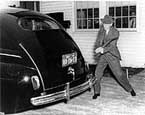Untitled Document
excerpt from:
Grown to drive ~ Metal, plastic, glass... and plants?
What kind of cars are they building?
What some might call the car of the future has already made its big debut.
The unveiling came in Dearborn — more than 50 years ago. David Morris,
executive director of the Minneapolis-based Institute for Local Self-Reliance,
described the event in a recent issue of his organization’s newsletter:
 "On
August 14, 1941, at the 15th Annual Dearborn Michigan Homecoming Day celebration,
Henry Ford unveiled his biological car. Seventy percent of the body of the cream-colored
automobile consisted of a mat of long and short fibers from field straw, cotton
linters, hemp, flax, ramie and slash pine. The other 30 percent consisted of
a filler of soymeal and a liquid bioresin. "On
August 14, 1941, at the 15th Annual Dearborn Michigan Homecoming Day celebration,
Henry Ford unveiled his biological car. Seventy percent of the body of the cream-colored
automobile consisted of a mat of long and short fibers from field straw, cotton
linters, hemp, flax, ramie and slash pine. The other 30 percent consisted of
a filler of soymeal and a liquid bioresin.
"The timing gears, horn buttons, gearshift knobs, door handles and accelerator
pedals were derived from soybeans. The tires were made from goldenrods bred
by Ford’s close friend Thomas Edison. The gas tank contained a blend:
about 85 percent gasoline and about 15 percent corn-derived ethanol."
To prove the vehicle’s superiority, Ford demonstrated the strength of
the car body by smashing an ax against the trunk, only to have it bounce off.
For some it remains a landmark event.
 "That’s
one of my favorite pictures," says Richard Wool, who is at the vanguard
of an emerging industry that’s rediscovering what Ford thought to be a
better way of making cars. Following in Ford’s track, Wool is developing
adhesive bioresins from soy oil at the University of Delaware. "That’s
one of my favorite pictures," says Richard Wool, who is at the vanguard
of an emerging industry that’s rediscovering what Ford thought to be a
better way of making cars. Following in Ford’s track, Wool is developing
adhesive bioresins from soy oil at the University of Delaware.
"To Henry Ford," wrote Morris, "the vegetable car was the perfect
vehicle for driving the American farmer out of a 20-year economic depression.
But after World War II, the maturation of the petrochemical industry and the
export-driven revival of American agriculture seemed to relegate the idea of
a biological car to the dustbins of history. Fifty years later, at the twilight
of the 20th century, Ford’s dreams are again attracting attention. Working
independently, scientists, engineers and entrepreneurs are finding more and
more ways to incorporate vegetable-derived products into your standard car."
From:
Popular Mechanics, December, 1941
Over in England it's saccharine for sugar; on the continent it's charcoal "gasogenes"
in the rumble seat instead of gasoline in the tank. Here in America there's
plenty of sugar, plenty of gasoline. Yet there's an industrial revolution in
progress just the same, a revolution in materials that will affect every home.
After twelve years of research, the Ford Motor Company has completed an experimental
automobile with a plastic body. Although its design takes advantage of the properties
of plastics, the streamline car does not differ greatly in appearance from its
steel counterpart.
The only steel in the hand-made body is found in the tubular welded frame on
which are mounted 14 plastic panels, 3/16 inch thick. Composed of a mixture
of farm crops and synthetic chemicals, the plastic is reported to withstand
a blow 10 times as great as steel without denting. Even the windows and windshield
are of plastic. The total weight of the plastic car is about 2,000 pounds, compared
with 3,000 pounds for a steel automobile of the same size. Although no hint
has been given as to when plastic cars may go into production, the experimental
model is pictured as a step toward materialization of Henry Ford's belief that
some day he would "grow automobiles from the soil."
When Henry Ford recently unveiled his plastic car, result of 12 years
of research, he gave the world a glimpse of the automobile of tomorrow, its
tough panels molded under hydraulic pressure of 1,500 pounds per square inch
from a recipe that calls for 70 percent ofcellulose fibers from wheat straw,
hemp and sisal plus 30 percent resin binder. The only steel in the car is its
tubular welded frame. The plastic car weighs a ton, 1,000 pounds lighter than
a comparable steel car. Manufacturers are already taking a low-priced plastic
car to test the public's taste by 1943.
Go to Original Article >>>
The views expressed herein are the writers' own and do not necessarily reflect those of Looking Glass News. Click the disclaimer link below for more information.
Email: editor@lookingglassnews.org.
|

